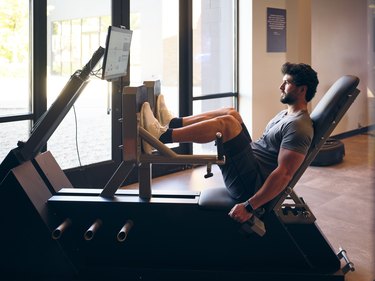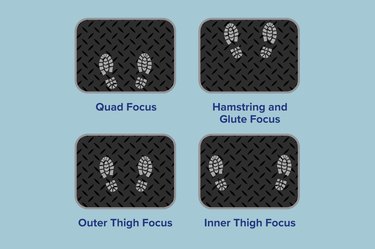
Whether you're looking to save your back from barbell-induced discomfort or just want to try some new exercise equipment, the leg press is a great tool to try at your gym.
But if you're new to this machine, you probably want to know the average weight for leg press exercises. Read on to learn more about your ideal leg press weight, how to program your reps and the best foot alignment for your goals.
Video of the Day
Tip
While there's no average leg press weight, you can find your own ideal weight, depending on your fitness level. Beginners should start with a weight that's 50 to 75 percent of their total body weight.
The Average Leg Press Weight
If you're wondering, "How much should I leg press?" there's no easy answer. As with most types of weightlifting, there's no single average weight for the leg press. The amount you can press depends on your age and fitness level.
People who frequently strength train may be able to leg press well over 100 pounds, whereas others may be challenged by pressing the machine alone.
Leg Press Weight for Beginners
Before you start throwing weight on the machine, figure out the average leg press weight to start with. If you've never used the machine before, first test a few weightless presses — sometimes called an empty leg press — before adding any plates, says New York-based physical therapist Sam Becourtney, PT, DPT, CSCS.
If that feels challenging, you can do your reps without adding any weight. If you're ready for more, build up to a leg press starting weight that's about 50 to 75 percent of your body weight, Becourtney says.
Remember, there's no such thing as a "good" or "bad" leg press weight. For many beginners, leg pressing 100 pounds is an excellent achievement. For more experienced lifters, a 500-pound leg press may be considered ideal. The goal is progress, after all.
Leg Press Weight for Intermediate and Advanced Lifters
As you grow more comfortable and experienced with the exercise, you can add more weight to the machine. Advanced lifters can usually press up to four or five times their body weight, Becourtney says.
Playing with your foot placement is another way you can progress the leg press machine, according to Carolina Araujo, CPT, a California-based strength coach. For instance, a high and wide foot placement can help you target more of your glute muscles. A narrow stance focuses in on your quads.
What's the Leg Press Weight Without Plates Added?
After using several leg press machines, you may notice some feel more challenging even when the weight you add is the same. That's because some leg press machines already have extra weight in the carriage.
Unfortunately, there's no one leg press weight without plates — it depends on the leg press machine you're using. Some leg presses can feel pretty weightless without plates, while some can weigh 45 pounds (or more) from the start. And just as with a barbell, people don't generally count the leg press machine weight when adding up your plates.
Before you start piling plates onto a leg press machine, do a few weight-free reps to know what to expect.
How to Leg Press Properly
Before you get your lower body working, make sure your leg press form is correct and avoid common leg press mistakes.
Leg Press
- Begin seated on the machine, bending your knees to a comfortable position.
- Plant your feet on the platform about hip-width apart, keeping your heels and balls of your feet planted.
- Place your head and back flat against the seat.
- Drive through your heels and push the platform away from your body without completely locking out your knees.
- Control the plate as you reverse the motion and bend your knees, bringing the weight back to the starting position.
You may notice a few different types of leg press machines in your gym. The seated leg press is one of the most common, which has a horizontal seat, Becourtney says.
You may also see a 45-degree or vertical leg press, which has you pushing upward at a diagonal angle. (Don't belong to a gym? Try these leg press alternatives to build a stronger lower body at home.)
You may even come across a lying leg press, where you lie flat on your back and push the press horizontally, although that's most common in a physical therapy setting.
While different machines may have you push the weight at varied angles, they generally work the same and use the same form and leg press position.
Tip
To avoid hurting your knees, don't lock out or fully straighten your knees as you press the platform away.
How to Position Your Feet for Maximum Leg Press Benefits

While the main muscles worked on the leg press machine are the quadriceps, leg press variations allow you to tweak your foot placement to target other muscles, Becourtney says, as shown in the graphic above.
To increase emphasis on your glutes and hamstrings, place your feet higher on the platform. To put more work on your quads, align your feet lower.
Leg Press Sets and Reps
Regularly using the leg press is a great way to improve your leg strength. But the way you program your sets and reps determines whether you focus on muscular size or endurance.
Generally, the amount of weight you're pressing should be inversely related to the amount of sets you perform, according to the American Council on Exercise (ACE). If you're a beginner and pressing about 50 percent of your body weight, aim for about 10 to 12 reps at the start, Becourtney says.
Then, once this weight and rep range start to feel comfortable, you can increase your weight gradually, adding small increments of weight each set or workout, depending on your comfort level. You want to increase toward a weight that's challenging but doesn't cause you to break down in form (this helps you avoid injuries).
"You should be able to complete the final 'working set' and only have 1 to 2 repetitions in reserve, meaning you were close to your maximum effort but did not reach a point of [form breakdown] where injury may be a risk," Becourtney says.
As you get stronger, you can increase your weight or reps depending on your goals. If you're looking to build muscular endurance (which is especially helpful if you play a sport), you can increase your reps gradually up to 30, according to the ACE.
Or, if you're training for hypertrophy (increased muscle size), you can keep your total reps low (6 or fewer reps) and increase your weight more quickly.
Leg Press Weight Chart With Reps and Sets
Fitness Goal | Weight (Beginners) | Weight (Advanced) | Reps | Sets |
|---|---|---|---|---|
Endurance | 50 to 75% of body weight | 4 to 5 times body weight | 20 to 30 | 4 to 5 |
Hypertrophy | 50 to 75% of body weight | 4 to 5 times body weight | 6 to 8 | 3 to 4 |
Was this article helpful?
150 Characters Max
0/150
Thank you for sharing!
Thank you for your feedback!